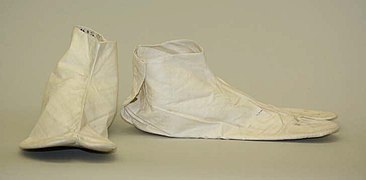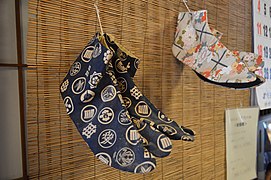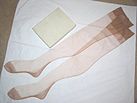
Tabi (足袋) are traditional Japanese socks worn with thonged footwear such as zori, dating back to the 15th century.
History
Japanese tabi are usually understood today to be a kind of split-toed sock that is not meant to be worn alone outdoors, much like regular socks. However, tabi were originally a kind of leather shoe made from a single animal hide, as evidenced by historical usage and the earlier form of the word, tanbi, written 単皮, with the kanji literally signifying "single hide". As Japanese footwear evolved, tabi also changed, with the split-toe design emerging towards the late Heian period (794–1185 CE) to allow the wearer to accommodate the thong of sandals. Outdoor versions of tabi involved some kind of reinforcement, with soles traditionally made of cloth, leather, or straw.
Brothers Tokujirō Ishibashi and Shōjirō Ishibashi, founders of the tyre company Bridgestone, are credited with the invention of rubber-soled jika-tabi in 1922; these are now the dominant form of outdoor tabi, and the term tabi generally refers to the indoor form.
Use

Tabi are worn by both men and women with traditional formal footwear such as zori, and sometimes the less-formal geta. Tabi are typically worn with clothing such as kimono. Tabi are sewn with a divided toe, in order to be worn with thonged footwear.
Historically, most people in Japan wore tabi, as most Japanese footwear was thonged; however, some, such as upper-class courtesans and the geisha of Fukagawa, did not wear them, as the bare foot was considered to be erotic in Japanese culture. Others, such as lower-working class members of society who could not afford tabi, either did not wear them or wore boots such as jika-tabi instead.
In traditional Japanese spaces and buildings, such as Noh theatres, teahouses and for traditional stage performances, tabi must be worn, and shoes are not worn inside or on stage.
Styles
The most common color of tabi is white, which represents purity. White tabi are worn in formal situations such as tea ceremonies. Men sometimes will wear blue or black tabi for traveling. Colored tabi are also available, and are sometimes used in kabuki theatre as part of a character's costume, or are worn with more casual outfits as fashion.
Traditionally, tabi are sewn from cloth cut to form. They are open at the back to be slipped on and have fasteners along the opening (known as kohaze) so they can be closed. Tabi sewn from stretch material without fasteners are also available.
Jika-tabi
Main article: Jika-tabiOne distinctive style of tabi are jika-tabi (地下足袋, lit. 'tabi that contact the ground'). Made of heavier, tougher material and often having rubber soles, jika-tabi resemble boots and are outer footwear rather than socks. Like other tabi, jika-tabi also have divided toes.
Modern versions
Contemporary tabi socks—socks with a separation between the big toe and the rest of the toes—are also available. This reflects the number of people who still prefer to wear zori and geta, especially during Japan's hot, humid summers.
Modern tabi occasionally have elastic openings instead of fasteners.
Belgian fashion house Maison Margiela has released modern boots with a separated big toe since the late 1980s-early 1990s. They can cost more than $1000 per pair. In 2023, the story of a man stealing a pair of tabi shoes from his Tinder date was amplified by TikTok and other social media sites.
A related item are toe socks, which have five separate compartments; these are known as gohon-yubi no kutsushita (5本指の靴下, five-toe socks) in Japanese.
Gallery
-
 Cotton-paper tabi, 1700s
Cotton-paper tabi, 1700s
-
 Cloth tabi with ties, early 1900s
Cloth tabi with ties, early 1900s
-
Modern tabi with kohaze hook-and-loop fasteners
-
 Knitted stretch-on tabi, no fasteners
Knitted stretch-on tabi, no fasteners
-
 Sheer tabi
Sheer tabi
-
 Woven tabi
Woven tabi
-
 Close-up of kohaze
Close-up of kohaze
-
 Sewing the loops
Sewing the loops
-
 Brightly patterned tabi
Brightly patterned tabi
-
Leather tabi, Edo period (1603–1867), precursors to modern jika-tabi
-
Tabi with reinforced hobnailed soles, Edo period
-
 Farmworkers wearing outdoor tabi, 1912
Farmworkers wearing outdoor tabi, 1912
-
 Early 20th century cloth-soled tabi boots (reconstruction of 1912 marathon tabi)
Early 20th century cloth-soled tabi boots (reconstruction of 1912 marathon tabi)
-
 A fisherman wearing tabi with sewn-on woven-straw soles, 1915
A fisherman wearing tabi with sewn-on woven-straw soles, 1915
-
 Modern tabi boots designed by Maison Margiela
Modern tabi boots designed by Maison Margiela
References
- Fisher, Sammi (2018-12-18). "Tabi Boots Take Over Parsons". The New School Free Press. Retrieved 2023-09-09.
- Nihon Kokugo Daijiten, entry for tabi available online here (in Japanese)
- Dajirin, second edition, 1995
- Shin Meikai Kokugo Jiten, fifth edition, 1997
- Sekai Dai Hyakka Jiten, second edition, entry available online here (in Japanese)
- Jun-ichi, Ishikawa, ed. (June 15, 2002). "Traditional Footwear". Nipponia (21). Tokyo Inshokan Printing Co., Ltd. Retrieved 8 June 2021.
- Encyclopedia Nipponica, entry available online here (in Japanese)
- Encyclopædia Britannica International, entry available online here (in Japanese)
- Mypedia, entry available online here (in Japanese)
- Sekai Dai Hyakka Jiten, second edition, entry available online here (in Japanese)
- ^ Manning, Emily (2015-11-17). "the weird and wonderful history of split-toe shoes". i-D. Retrieved 2021-03-05.
- "Clothing". www.samurai-archives.com. Retrieved 2020-10-18.
- Gallagher, John (2003). Geisha: A Unique World of Tradition, Elegance, and Art. Sterling Publishing Company, Inc. p. 167. ISBN 978-1-85648-697-2.
- "Morimoto Nohbutai - A Noh Experience". Fukuoka Now (in Japanese). 2015-08-26. Retrieved 2021-03-05.
- M. Shaver, Ruth (1966). Kabuki Costume (1st ed.). Tuttle Publishing. ISBN 978-0804816502.
- Kimino, Rinko; Somegorō, Ichikawa (2017). Photographic Kabuki Kaleidoscope. Shogakukan. ISBN 978-4093108430.
- "Traditional tabi socks let you sneak around like a modern ninja while providing maximum comfort". Japan Today. 14 December 2017. Retrieved 2021-03-05.
- "Martin Margiela, the one and onlyMartin Margiela, the one and only". The Fashion Commentator. 2012-11-17. Retrieved 2021-03-05.
- "Margiela by Candlelight in S/S92". AnOther. 2015-08-12. Retrieved 2021-03-05.
- Roy, Jessica (2023-09-07). "After Two Dates, Her Designer Shoes Went Missing". The New York Times. ISSN 0362-4331. Retrieved 2023-09-09.
External links
- The Museum of Tabi website (in Japanese)
- Tabi at the Museum of Applied Arts and Sciences
- Tabi at the University of Michigan Museum of Art
- Tabi at the Metropolitan Museum of Art
- Maison Martin Margiela: Women's tabi boots at the RISD Museum
| Japanese clothing | ||
|---|---|---|
| List of items traditionally worn in Japan | ||
| Traditional |  | |
| Headgear | ||
| Belt / sash | ||
| Footwear | ||
| Hosiery | ||
|---|---|---|
| Lower leg |  | |
| Full leg | ||
| Full body | ||
| Historical | ||
| Brands | ||
| Men's undergarments | |
|---|---|
| Upper body | |
| Lower body | |
| Full body | |
| Hosiery | |
| Historical | |
| Brands |
|